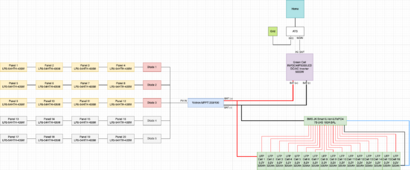If your AIO can provide enough power to run all of your loads, then there shouldn't be a need for a transfer switch. Either you're running off of battery/solar and the AIO powers everything, OR, you're passing grid power through the AIO to power everything.
On the other hand, if your AIO can't provide enough power to run all of your loads, then you would need a transfer switch to change over your loads from the AIO to grid. I don't have any experience with this, as my setup is off-grid, but others on the forum will be able to provide guidance if you have specific questions.
That depends on how much power 'all my electrical needs' is. I run an off-grid cabin on a 3500W inverter with no problems, but I don't have any really big constant loads like electric dryer, air conditioning, electric stove, or water heater.
My Opinion - (and some may differ with my take on things and I may be totally wrong)
So I was deeply disappointed to learn that the typical AIO can't handle the full load of a modern house when you read the fine print.
Something like the Sol-Ark 15k or the EG4-18k ... which is misleading anyways since that wattage rating is for the solar only. The Sol-Ark has a built in 200amp pass through switch and it will happily transfer back and forth. But the actual output of the inverter is only 62.5 amps when fully loaded with panels and 50 amps without and running from a sufficient sized battery bank. This is across both legs of the power panel. In the US that number is enough for common items in a gas based household in a mild climate. A/C takes more than that to function and so does an electric oven or a electric water heater or a heat pump. That is skipping the pesky issue of startup for the motors. And, don't even try a hot tub, pool heater or electric furnace.
So if you do manage to overload the 200amp transfer relay/contactor can it be field replaced or do you have to ship it back and wait then install a new one?? I dunno to be honest?
So, what does that leave? A main panel that is tied to a line tap which also feeds a transfer switch. The main panel has breakers 2 pole breakers in it which are hooked up to the AIO. In order to have enough AIO capacity to run the 200amp household you need 4 of these units to be off-grid entirely. And if you are going to be totally off-grid with 4 of the units why would you use an AIO? Chances are you have a large battery bank and a large overpanneled solar array with large enough inverters to run it all.
Seems to me that the AIO market for the Sol-Ark is aimed at people adding solar to their grid tied home. In that case you install it, tie everything to it and put a critical load panel with the things you can't live without. The transfer switch isn't overloaded and only triggers when your batteries are low after a few bad days. Otherwise the critical load panel is always on battery.
None of this gets you away from needing to tie to the grid if you want to have the extra power be available and use a smaller battery bank.
So, download the EG4-18kpv manual and look at page 35 for the easiest way to wire things in. Sub the inverter/MPPT/charger of your choice instead of the EG4 or Sol-Ark and the design is the same.
And, forgive me if I am wrong, but at this point I am soured on the AIO all together and will probably smurf together a system.



